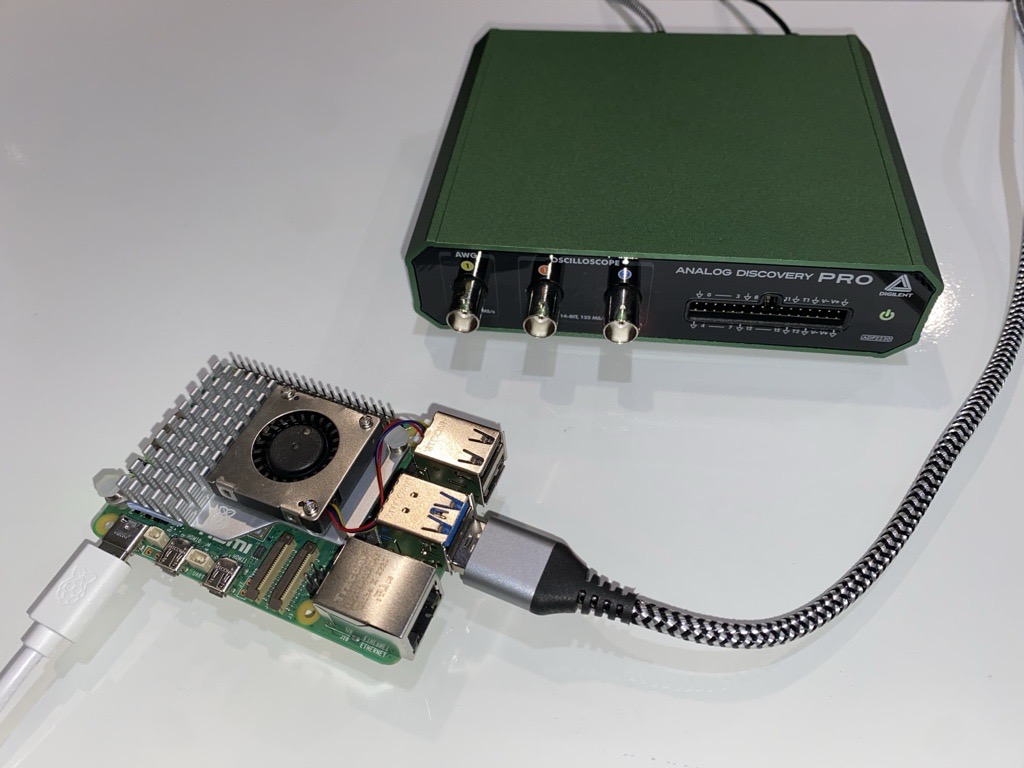The release of the Raspberry Pi 5 marks another significant milestone in the evolution of single-board computing. With the introduction of a new product, there is often notable enthusiasm surrounding the potential offered by the device. In this blog, Digilent’s WaveForms software was paired with the recently released Analog Discovery Pro (ADP2230) and a Raspberry Pi 5 for test and measurement applications.

The Raspberry Pi 5 boasts several improvements over its predecessors, making it even more versatile and powerful. With its upgraded quad-core processor and increased RAM capacity, it delivers enhanced performance, making it suitable for a wide range of computing tasks, from basic programming projects to test and measurement and data acquisition. Additionally, the Raspberry Pi 5 module’s affordability, energy efficiency, compact size, customization options, community support, and educational value make it a compelling choice for a wide range of engineering tasks, projects, and applications.
Digilent’s WaveForms software seamlessly integrates with the Raspberry Pi 5, offering a powerful combination for data acquisition, analysis, and visualization tasks. This compatibility extends the capabilities of the Raspberry Pi 5, allowing users to leverage WaveForms’ intuitive user interface and comprehensive suite of digital instrumentation tools for a wide range of applications. Whether capturing signals from sensors, performing real-time analysis, or visualizing data, the Raspberry Pi 5 and WaveForms software work hand in hand to provide a versatile and efficient solution for engineers, researchers, and hobbyists alike. Users can easily connect a Digilent Test and Measurement device, i.e. an Analog Discovery Pro (ADP2230), to a Raspberry Pi 5 allowing them to collect data from various sources with ease.

Furthermore, WaveForms offers advanced signal processing capabilities, enabling engineers to perform real-time analysis on acquired data. Whether it’s filtering out noise, extracting meaningful information from complex signals, or performing statistical analysis, WaveForms provides engineers with the tools they need to derive insights from their data. WaveForms also supports seamless integration with popular programming languages such as Python, allowing engineers to automate data acquisition and analysis tasks. This enables the development of custom data acquisition solutions tailored to specific applications.
In conclusion, the release of the Raspberry Pi 5 brings affordability, energy efficiency, compact size, customization options, community support, and educational value making it a compelling choice for a wide range of engineering tasks, projects, and applications. Moreover, it serves as a valuable educational resource for programming, electronics, and computer science, appealing to students and hobbyists due to its affordability and accessibility. Coupling with Digilent’s WaveForms software support, the combination serves as a versatile tool in the fields of test and measurement and data acquisition. By leveraging the capabilities of the Raspberry Pi 5 and WaveForms software, engineers can acquire, analyze, and visualize data for a wide range of applications with unprecedented ease and efficiency. Come explore the potential of this powerful combination and its implications for future projects and innovations.
To get started using Digilent’s Analog Discovery Pro (ADP2230), WaveForms software, and a Raspberry Pi 5, reference the Getting Started with Raspberry Pi and a Test and Measurement Device guide.
Access additional resources in Reference and get answers to specific questions in our user forum.


Good article but it has to be noted:
You must download and install the Adept 2 runtime before installing Waveforms. It is on a different download page from Waveforms.
In the Adept runtime download page it shows a “Raspberry PI” version, but this is no good for a new PI 5 with the now-stock 64-bit Bookworm. Use the Arm Debian 64-bit version on the top right.
After installing this the Waveforms install will work. Again, you need the 64-bit ARM Linux version.